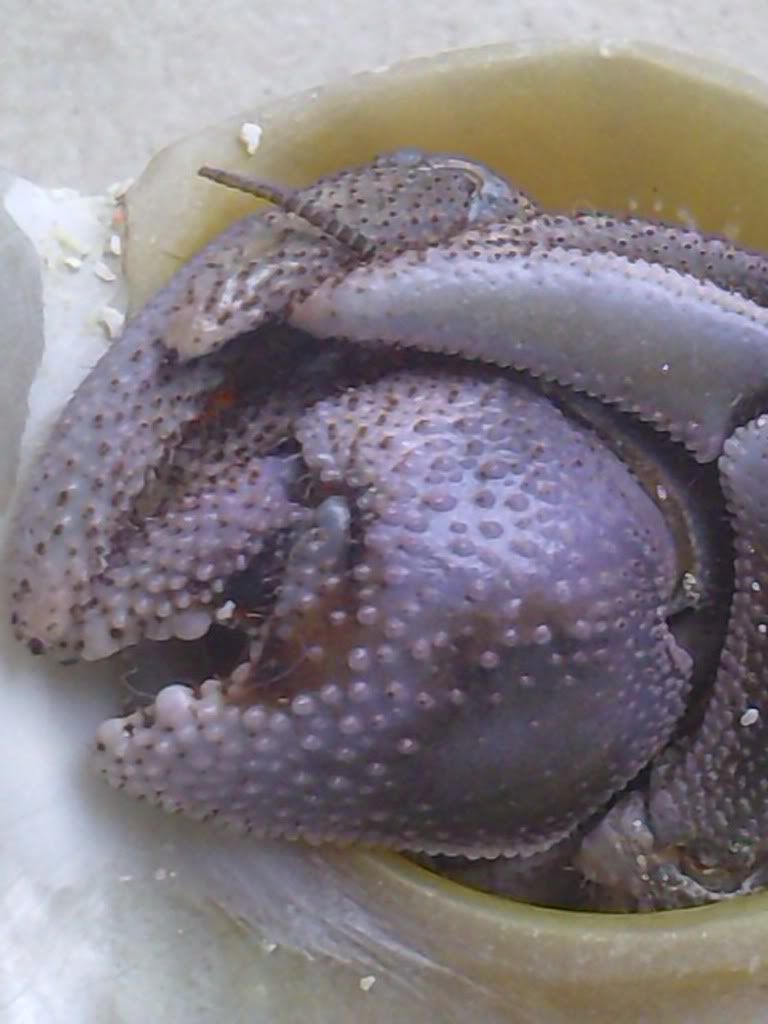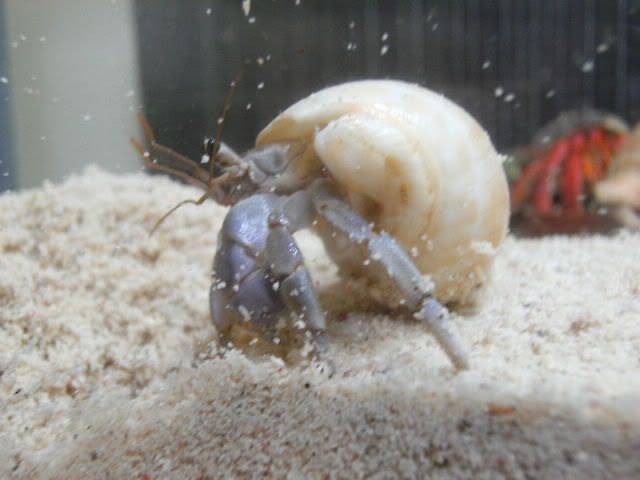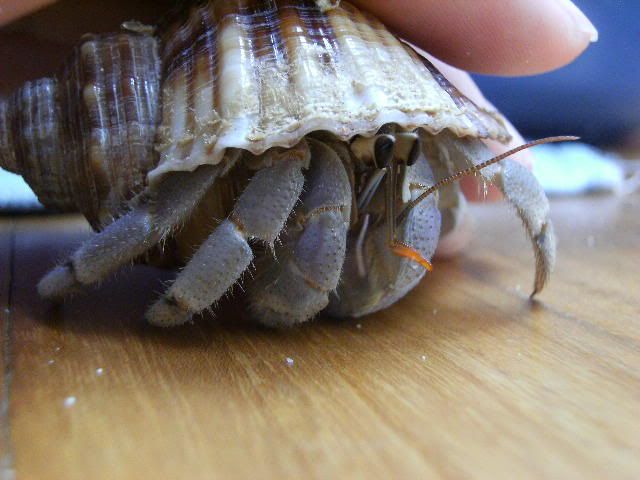Page 1 of 2
Okinawa purpuresu & Indonesian-born C.purpureus
Posted: Thu Jul 01, 2010 5:40 am
by tonycoenobita
Some people said C. purpureus are also found in Indonesia, but I compare the picture between Indonesian purpureus and Okinawa purpuresu.
There are some different.
Indonesian purpureus:
Have bLack colour under eye stick, no ridge (///) on big claw. Any many spot on body.

Okinawa purpuresu:
No back spot on eye, have ridge (///) on big claw.

May be they are 2 different species, but as body colour of Indonesian purpureus is in purple, so some of you think that they are same.
Any idea?
Posted: Thu Jul 01, 2010 8:37 pm
by JediMasterThrash
If you closely compare the two crabs to other known species, I'd say that the Indonesian Purpureus looks a lot like a purple variabilis, and the Okinawan Purpureus looks a lot like a purple rugosus.
They definitely have different body structures. They are similar in color only. In fact I'd say they aren't even similar in color, the indonesian is more purple and the okinawan is more blue. But of course color is affected by many variables.
Posted: Thu Jul 01, 2010 9:14 pm
by Guest
Wow that is some interesting food for thought

Posted: Fri Jul 02, 2010 7:20 am
by tonycoenobita
JediMasterThrash wrote:If you closely compare the two crabs to other known species, I'd say that the Indonesian Purpureus looks a lot like a purple variabilis, and the Okinawan Purpureus looks a lot like a purple rugosus.
They definitely have different body structures. They are similar in color only. In fact I'd say they aren't even similar in color, the indonesian is more purple and the okinawan is more blue. But of course color is affected by many variables.
So, we cannot use "Purpureus" to name this "Indonesian" purple species!?
Posted: Fri Jul 02, 2010 9:31 am
by Guest
tonycoenobita wrote:
So, we cannot use "Purpureus" to name this "Indonesian" purple species!?
Well no because they are very different in many physical aspects, as well as the fact they wouldn't breed together in the wild.
Posted: Fri Jul 02, 2010 10:41 am
by JediMasterThrash
Well we don't actually know if they can breed or not. Donkeys and Horses look different but can still breed.
"Species" classification is somewhat arbitrarily defined, and it is not always true that different species can't breed.
Assuming the variation is not just due to "age" factors, I would be inclined to think they are a different species. I would be more inclined to think one is a variation of violascens or rugosus rather than both being variations of purpureus. But someone would need to do some scientific analysis on some samples to know for sure.
Posted: Fri Jul 02, 2010 1:37 pm
by kgbenson
JediMasterThrash wrote: Donkeys and Horses look different but can still breed.
For a single generation only, and the offspring are sterile, so from a popualtion and species POV, they are really not accomplishing any breeding in the functional sense.
"Species" classification is somewhat arbitrarily defined, and it is not always true that different species can't breed.
They cannot breed true and produce reproductively viable offspring according to most definitions where the issue is part of the species criteria at all.
Assuming the variation is not just due to "age" factors, I would be inclined to think they are a different species. I would be more inclined to think one is a variation of violascens or rugosus rather than both being variations of purpureus. But someone would need to do some scientific analysis on some samples to know for sure.
Initially I would assume that the pics may not be representative of the species at all. Ideally there would be shots from multiple angles of several animals from both areas - otherwise it is pretty tough to draw any conclusions. Of course a little DNA work wouldn't hurt either!
Keith
Posted: Fri Jul 02, 2010 1:48 pm
by kgbenson
This animal is supposed to be from Okinawa:
http://crabstreetjournalphotos.com/albu ... pureus.jpg
But again - different angle, different details visible etc.
Felix may have some additional pics with more details.
Keith
Posted: Fri Jul 02, 2010 2:03 pm
by Spiral
Posted: Fri Jul 02, 2010 2:44 pm
by Guest
JediMasterThrash wrote:Well we don't actually know if they can breed or not. Donkeys and Horses look different but can still breed.
"Species" classification is somewhat arbitrarily defined, and it is not always true that different species can't breed.
Assuming the variation is not just due to "age" factors, I would be inclined to think they are a different species. I would be more inclined to think one is a variation of violascens or rugosus rather than both being variations of purpureus. But someone would need to do some scientific analysis on some samples to know for sure.
Donkeys and horses don't produce viable offspring though

and in my biology class if two animals can breed in the wild naturally and produced viable offspring and had similar characteristics in behavior and appearance they were the same species if they couldn't breed because they were separated geologically that would make them a different species. So I'd definitely consider them separate species.
Posted: Fri Jul 02, 2010 3:22 pm
by wodesorel
Hermitcrazy wrote:Donkeys and horses don't produce viable offspring though

Only because they have as different number of chromosomes. Horses have 64 chromosomes while donkeys only have 62. Mules have 63 chromosomes and so cannot interbreed. (What's really neat is that female mules can sometimes indeed be fertile, but only if they breed with a full horse or a full donkey. So even though they're 50% donkey and 50% horse, if they're bred to a 100% horse their foal will be 100% horse.)
If the chromosomes matches on the hermit crabs then it could indeed be possible for them to interbreed. Look at canines - dogs, wolves, and coyotes can all interbreed even though they are different species because they all have 78 chromosomes.
Posted: Fri Jul 02, 2010 11:50 pm
by tonycoenobita
You can see the 2nd photo, there is no ridge (///) on big claw.
Posted: Fri Jul 02, 2010 11:53 pm
by Mokulele_Hawai'i
However, I also have Indonesian blueberries with ridges or stitch mark on the BP:

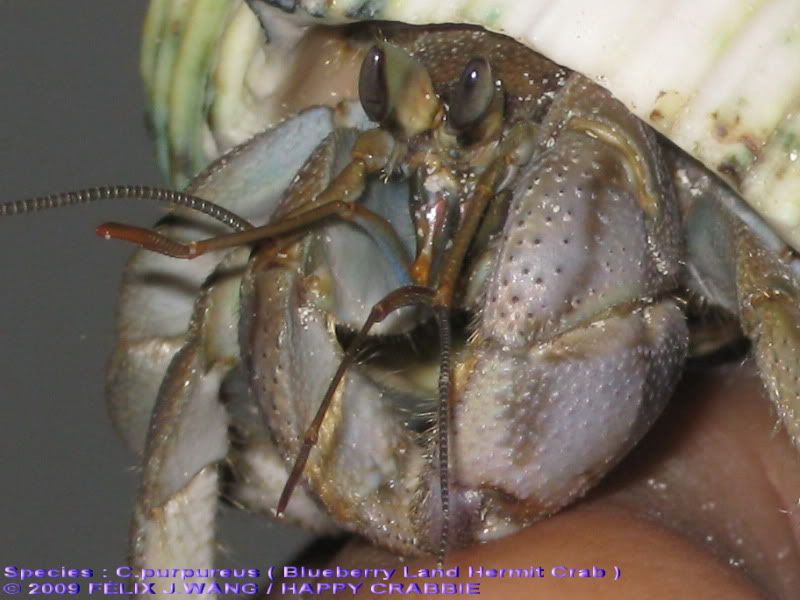
.... while some of them without the stitch marks ( especially the jumbo/large ones - the stitches seem to be obscured by the granules or hair setae on the BP ):
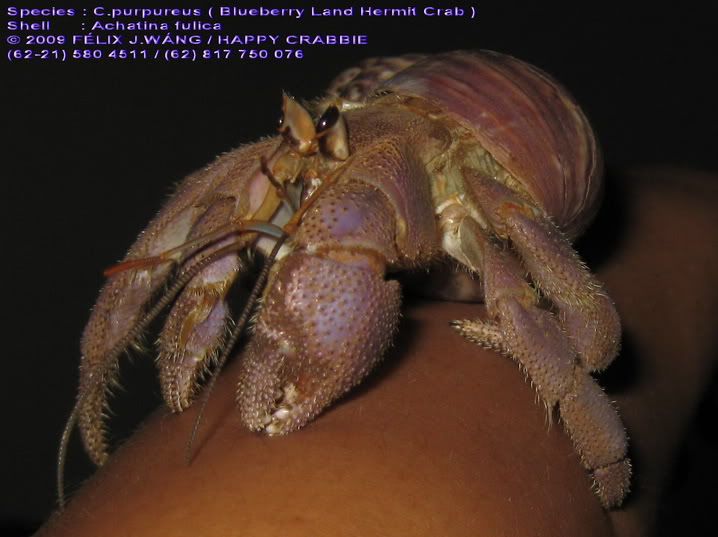
I still believe that the Indonesian blueberry is still
C.purpureus but belongs to diffferent sub-species. The antennae are really similar to the Japanese blueberry.
And it's true - some of their body parts resemble
C.variabilis.
Posted: Fri Jul 02, 2010 11:56 pm
by suebee
as always great photos Felix! thanks for sharing..
Posted: Sat Jul 03, 2010 2:35 am
by tonycoenobita
Mokulele_Hawai'i wrote:However, I also have Indonesian blueberries with ridges or stitch mark on the BP:


.... while some of them without the stitch marks ( especially the jumbo/large ones - the stitches seem to be obscured by the granules or hair setae on the BP ):

I still believe that the Indonesian blueberry is still
C.purpureus but belongs to diffferent sub-species. The antennae are really similar to the Japanese blueberry.
And it's true - some of their body parts resemble
C.variabilis.
The 1st one may be only a rug?





